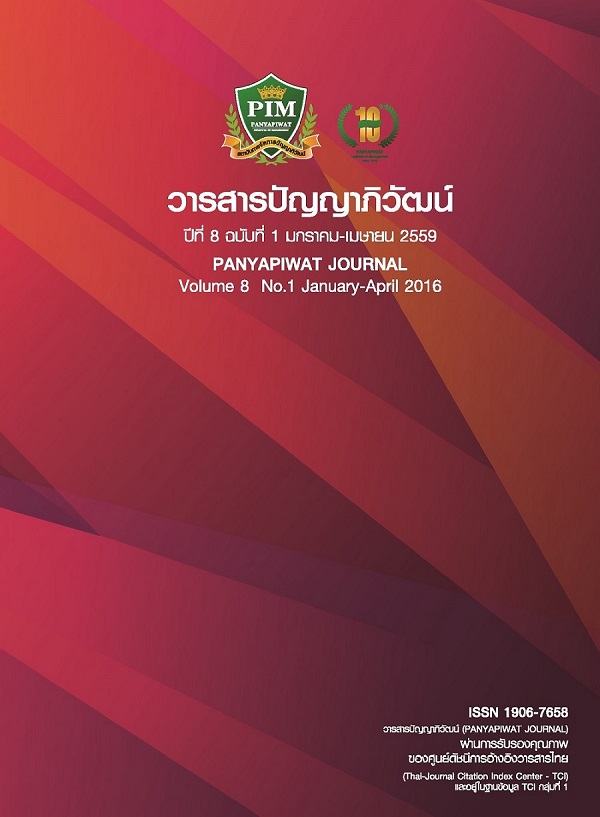ENHANCED E-GOVERNMENT TRANSPARENCY THROUGH LINKED OPEN DATA
Main Article Content
บทคัดย่อ
Transparency is an important issue for government. Even after the transformation to e-Government the issue of transparency remains in question. The Government has converting the traditional process into an online process e-Government aims to increase access and enhance transparency. However some activities that lead to corruption are still able to occur intentionally or unintentionally. Sometime these activities can occur even prior the process. E-Government collaboration can reduce some of these illegal activities. This paper proposes an approach to improve transparency effectively through e-Government collaboration, using Linked Open Data to link data from different documents together. A case study of transparency improvement in provincial budgeting in Thailand is presented to verify the effectiveness of the proposed approach.
ความโปร่งใสนับเป็นประเด็นสำคัญสำหรับรัฐบาล ซึ่งความโปร่งใสนั้นก็ยังเป็นคำถามแม้ว่าจะได้มีการเปลี่ยนรูปแบบเป็นรัฐบาลอิเล็กทรอนิกส์ โดยการปรับเปลี่ยนกระบวนการทำงานแบบเดิมให้เป็นรัฐบาลอิเล็กทรอนิกส์ซึ่งทำงานในรูปแบบออนไลน์เพื่อเพิ่มการเข้าถึงข้อมูลและความโปร่งใสในการทำงาน แม้กระนั้นกิจกรรมบางอย่างที่ชักจูงไปทางคอรัปชั่นก็สามารถเกิดขึ้นได้โดยตั้งใจหรือไม่ตั้งใจ ซึ่งบางครั้งกิจกรรมเหล่านั้นอาจจะเริ่มก่อนที่กระบวนการจะเกิดขึ้น การทำงานร่วมกันของรัฐบาลอิเล็กทรอนิกส์สามารถช่วยลดกิจกรรมที่ไม่ถูกต้องเหล่านั้นได้ บทความวิจัยนี้นำเสนอแนวทางในการปรับปรุงความโปร่งใสอย่างมีประสิทธิภาพผ่านการทำงานร่วมกันของรัฐบาลอิเล็กทรอนิกส์ โดยการใช้การเชื่อมต่อข้อมูลแบบเปิด (Linked Open Data) เพื่อเชื่อมต่อข้อมูลต่างๆ เข้าด้วยกัน แนวทางที่นำเสนอได้นำไปใช้ในกรณีศึกษาในการปรับปรุงความโปร่งใสของการของบประมาณของจังหวัดในประเทศไทย
Article Details
“ข้าพเจ้าและผู้เขียนร่วม (ถ้ามี) ขอรับรองว่า บทความที่เสนอมานี้ยังไม่เคยได้รับการตีพิมพ์และไม่ได้อยู่ระหว่างกระบวนการพิจารณาลงตีพิมพ์ในวารสารหรือแหล่งเผยแพร่อื่นใด ข้าพเจ้าและผู้เขียนร่วมยอมรับหลักเกณฑ์การพิจารณาต้นฉบับ ทั้งยินยอมให้กองบรรณาธิการมีสิทธิ์พิจารณาและตรวจแก้ต้นฉบับได้ตามที่เห็นสมควร พร้อมนี้ขอมอบลิขสิทธิ์บทความที่ได้รับการตีพิมพ์ให้แก่สถาบันการจัดการปัญญาภิวัฒน์หากมีการฟ้องร้องเรื่องการละเมิดลิขสิทธิ์เกี่ยวกับภาพ กราฟ ข้อความส่วนใดส่วนหนึ่งและ/หรือข้อคิดเห็นที่ปรากฏในบทความข้าพเจ้าและผู้เขียนร่วมยินยอมรับผิดชอบแต่เพียงฝ่ายเดียว”
เอกสารอ้างอิง
Albornoz, F., Esteban, J. & Vanin, P. (2009). Government Information Transparency. Retrieved October 8, 2009, from http://ssrn.com/abstract=1407162Berners-Lee, T. (2006). Linked Data. Retrieved March 3, 2009, from http://www.w3.org/DesignIssues/LinkedData.html
Bhatnagar, S. (2003). Transparency and Corruption: Does E-Government Help?. Retrieved July 8, 2009, from http://www.iimahd.ernet.in/~subhash/pdfs/CHRIDraftPaper2003.pdf#search=’can%20egovernance%20curb%20corruption%20in%20tax%20departments
Blöndal, J. R. (2003). Budget Reform in OECD Member Countries: Common Trends. OECD Journal of Budgeting, 2(4), 7-26.
Charalabidis, Y. & Metaxiotis, K. (2009). Ontology-Based Management of e-Government Knowledge.IGI Global. Retrieved March 3,2010, from http://www.semic.eu/semic/view/documents/Ontology-Based-Management-Charalabidis.pdf
Chen, X. (2009). Towards Transparent E-Government Systems - a View from Formal Methods.PhD thesis, Japan Advanced Institute of Science and Technology.
Fan, Y., Zhang, Z. & Yue, Q. (2009). ‘E-government, Transparency and Anti-corruption’. Paper Presented at 2009 International Conference on Management of e-Commerce and e-Government. September 16-19, 2009. Nanchang, China.
Hu, C. & Liang, M. (2008). Ontology-based Framework for E-Government Knowledge Collaboration Service. Paper Presented at 4th International Conference on Wireless Communications, Networking and Mobile Computing, Dalian, China.
Ju, C. & Zhang, C. (2008). A Collaboration Model for E-government Based on Semantics and Multi-agent. Paper presented at International Symposium on Electronic Commerce and Security (ISEC2008), Guangzhou, China.
Mehmet, B. (2001). ‘Corruption, Connections and Transparency: Does a Better Screen Imply a Better Scene?’. Public Choice, 107(1), 87-96.
Na Lamphun, P. & Wuwongse, V. (2012). ‘Inter-Governmental Collaboration Through E-Document Computation: A Case Study of Provincial Budgeting in Thailand’. IJICTHD 4(1), 1-23.
Ndou, V. (2004). ‘E-Government for Developing Countries: Opportunities and Challenges’. The Electronic Journal on Information Systems in Developing Countries, 18(1), 1-24.
Oasis. (2002). Open Document Format for Office Applications (OpenDocument). Retrieved April 4, 2009, from http://docs.oasis-open.org/office/v1.1/OS/OpenDocument-v1.1-html/OpenDocument-v1.1.html
Thacker, M. (2011). Open Linked Data to Inform Policy and Improve Services. Retrieved January, 2012, from http://www.epractice.eu/files/European%20Journal%20epractice%20Volume%2012_3.pdf
W3C. (2008). SPARQL Query Language for RDF. Retrieved October 9, 2009, from http://www.w3.org/TR/rdf-sparql-query/
Wescott, C. (2001). ‘E-Government in the Asia-Pacific Region’. Asian Journal of Political Science, 9(2), 1-24.


